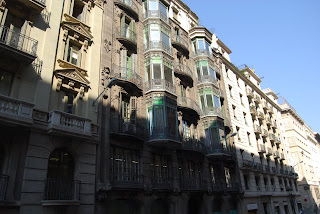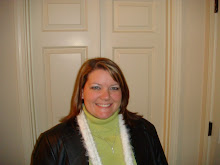Our next stop was in the port city, Livorno. There was nothing to do there, since it is mostly an unloading port for cargo to be shipped to Pisa and Florence. We chose not to visit Florence or Pisa. Robert had a friend that lived in Italy who told him that Pisa is not at all exciting. All there is there are pick-pocketers and the leaning tower. His friend also told us that when you visit Tuscany.... you want to see the countryside, so we chose the excursion that took us to Lucca .

This is the port of Livorno. I like the striped smoke stacks.
(By-the-way, you can click on any picture to see it in a bigger size.)
Livorno used to be swamplands and infested with mosquitos. Malaria became a big problem until the Italians found a mushroom-shaped pine tree that scared off mosquitos due to the pollen. They also found that sunflowers grew well there. Here is a picture of the pines and sunflowers.

Our tour was a 45 minute drive through the countryside. Lucca, pronounced (Loo-cuh), was a neat old village. The old part of Lucca is surrounded by a huge brick wall, and it is still all intact. There are trees, grass, and flowers growing along the top of the wall. Many people like to walk along the top of the wall. The "new" Lucca is outside the walls.

Notice the trees on top of the wall surrounding old Lucca. (Unfortunately, we could only get pictures from inside the bus.)

To the right is a gate that leads into old Lucca. You can see more of the wall topped with trees.
Lucca became a Roman colony in 180 BC. A famous opera composer, Giacomo Puccini (La bohème and Madama Butterfly), was born in Lucca.

Mom, Dad, and Me in old Lucca

A statue of Puccini
There are many richly built medieval basilica-form churches especially for such a small village. Our tour guide told us that many of the wealthy families in Lucca would try to "out do" the other families in building their church. This beautiful church, the San Michele in Foro, was built during the 13th century with the intent of finishing the building behind its beautiful facade.... but they ran out of money.

Notice the different columns

Interesting how it appeared from the front to be a very tall church.

A clock that's over 300 yrs. old.

There were many private gardens throughout Lucca.
There were also many towers throughout Lucca to provide a lookout, a place to cool off, and to build status among the city. These were later transformed into extra rooms for apartments.

Robert climbed up this 15 story tower, the tallest tower in Lucca (in the far background of this picture.) Notice the trees growing on top. Robert appreciated the shade they provided as he took more pictures of Lucca.

A view of Lucca

A view of the Piazza Anfiteatro

Proof that Robert made it to the top of a very tall tower!
Napolean took over Lucca in 1805 and made his sister govenor of Lucca. She tore down some buildings behind her palace because she wanted open space. They now use that square as a place for entertaining concerts and festivals. (I hope I am not boring you with the history, but I found it interesting and I'm not usually one who enjoys history.)

Napolean's sister's palace.
Later that day we drove to a house out in the countryside for wine and lunch. The owner of the house produces his own wine and olive oil (which we bought a bottle of.) The view from his house was breathtaking! Hills full of olive trees and grape vineyards!

Here are the olive trees with a beautiful view behind.

Robert and I eating lunch at the farm house in Tuscany.
After lunch we headed to the Villa Lucchese and toured a beautiful summer palace. The gardens around the palace were impressive. There was a pool and 3 fountains and many beautiful statues. The inside of the palace was just as impressive. The ceilings were covered in frescos and some of the furniture was covered in elaborate needlepoint.

The summer palace in Villa Lucchese

Beautiful gardens

The statues in this garden are between 200 to 300 years old.
Lucca is a place you should definitely visit if you ever travel to Tuscany!!



.JPG)






















